Tenant Satisfaction Survey 2024
Executive Summary
Introduction
East Dunbartonshire Council commissioned Research Resource to carry out a tenant satisfaction survey on their behalf.
A total of 1,186 interviews were carried out with East Dunbartonshire Council tenants in order to assess satisfaction with the Council’s Housing Service and the services it provides. Interviews took place between the 27th February and the 25th April 2024. 1,186 interviews provide data accurate to +2.4%.
Analysis of the participant profile shows that the survey sample is representative by geography. This provides robust and representative data upon which the Council can be confident about making decisions.
This executive summary highlights the key findings from this programme of research.
Scottish Housing Regulator Indicators
The following table shows the results for the Scottish Housing Regulator indicators for East Dunbartonshire Council, compared to the Council’s previous tenant satisfaction survey s undertaken annually since 2015 through to 2022. This latest survey was carried out in 2024. All surveys have been carried out using a telephone survey methodology. All surveys previously were carried out with c. 510 respondents. In 2024, a much larger number of interviews were carried.
The most recent survey, compared to previous surveys, shows the following trend:
- Overall satisfaction with the services provided by East Dunbartonshire Council continued to decrease, most recently falling from 76% satisfaction in 2022 to 71% in 2024. This is lower than the Scottish Local Authority average for the Annual Return on the Charter 22/23 when 83% were satisfied overall.
- The proportion of tenants who were of the opinion the Council were good at keeping them informed has also decreased, from 83% in 2022 to 78% in 2024. This is just marginally below the Scottish Local Authority average of 81%.
- Satisfaction with opportunities to participate has increased from 79% in 2022 to 88% in 2024. This is in line with what was reported in 2019 and 2020. This is significantly higher than the Scottish Local Authority average of 77%.
- Satisfaction with the quality of the home has not changed significantly, sitting at 78% in 2024 compared to 79% in 2022. this is also similar to 2017 and 2018 when 80% were satisfied with the quality of the home. This is just slightly lower than the Scottish Local Authority average of 82%.
- Satisfaction with East Dunbartonshire Council’s contribution to the management of the neighbourhood decreased with 74% of respondents satisfied in 2024 compared to 79% in 2022. This is below the Scottish Local Authority average of 85%.
- The proportion of tenants who were of the opinion the rent for their property represents good value for money decreased slightly with 79% saying it was good value in 2022 compared to 76% in 2024. This is below the Scottish Local Authority Average of 82%.
Taking everything into account, how satisfied or dissatisfied are you with the overall service provided by East Dunbartonshire Council’s Housing Service? (% very/fairly satisfied)
2017 - 82%
2018 - 82%
2019 - 81%
2020 - 82%
2021 - 79%
2022 - 76%
2024 - 71%
Scottish LA Average 22/23 - 83%
How good or poor do you feel East Dunbartonshire Council’s Housing Service is at keeping you informed about their services and decisions?
(%very good/ fairly good)
2017 - 82%
2018 - 92%
2019 - 84%
2020 - 87%
2021 - 89%
2022 - 83%
2024 - 78%
Scottish LA Average 22/23 - 81%
How satisfied or dissatisfied are you with the opportunities given to you to participate in East Dunbartonshire Council’s Housing Service’s decision making process? (% very/fairly satisfied)
2017 - 81%
2018 - 96%
2019 - 87%
2020 - 87%
2021 - 93%
2022 - 79%
2024 - 88%
Scottish LA Average 22/23 - 77%
Overall, how satisfied or dissatisfied are you with the quality of your home? (% very/ fairly satisfied)
2017 - 80%
2018 - 80%
2019 - 88%
2020 - 86%
2021 - 82%
2022 - 79%
2024 - 78%
Scottish LA Average 22/23 - 82%
Overall, how satisfied or dissatisfied are you with East Dunbartonshire Council’s Housing Service’s contribution to the management of the
neighbourhood you live in?
2017 - 84%
2018 - 86%
2019 - 82%
2020 - 78%
2021 - 82%
2022 - 79%
2024 - 74%
Scottish LA Average 22/23 - 85%
Taking into account the accommodation and services East Dunbartonshire Council’s Housing Service provides, to what extent do you think that the rent for this property represents good or poor value for money? Is it… (% very good value/ fairly good value)
2017 - 81%
2018 - 85%
2019 - 82%
2020 - 82%
2021 - 81%
2022 - 79%
2024 - 76%
Scottish LA Average 22/23 - 82%
Key Findings
The following points summarise the key findings to emerge from East Dunbartonshire Council’s
Tenant Satisfaction Survey 2024:
- Just over 7 in 10 tenants (71%) were very or fairly satisfied with the overall service provided by East Dunbartonshire Council Housing Service as their landlord.
- Tenants were most likely to use letters (47%), newsletters (40%) and email (23%) to obtain information.
- Just under 8 in 10 tenants (78%) said that the Council’s Housing Service was very or fairly good at keeping them informed about their services and decisions.
- Just over half of tenants (53%) were aware of at least one activity in which they could become involved in their landlord’s decision-making processes. Awareness was highest in terms of:
- Customer satisfaction questionnaires (27%)
- Open Days and Exhibitions (33%)
- Being part of a focus group to look at a particular area of service (29%)
- Going along to the Tenants Participation Working Group (26%)
- Becoming a member of a Registered Tenants’ and Residents Organisation (26%)
- Just under 1 in 5 tenants (17%) stated they would be interested in participating in at least one activity. Tenants were most likely to be interested in:
- Answering customer satisfaction questionnaires (11%)
- Online questionnaires through email and QR codes (9%)
- Giving feedback on specific issues such as consultation on rents and local housing strategy (7%)
- Being part of a focus group to look at a particular area of service (7%)
- Going along to Tenant Participation Working Groups (6%).
- The key reasons for not getting more involved were a lack of interest (38%) or health / disability issues (26%).
- Just under 9 in 10 respondents (88%) were very or fairly satisfied with the opportunities given to them to participate in the Council’s Housing Services decision-making processes.
- 64% of tenants were very or fairly satisfied with how Housing Services listens to their views and acts upon them in the monitoring and development of services.
- The vast majority of tenants were aware of their own responsibilities as a tenant in relation to the maintenance of their home (95%) and aware of the Council’s responsibilities in relation to the maintenance of their home (90%).
- Overall, 65% of all respondents were very or fairly satisfied with the way the Council’s Housing Service deals with repairs generally.
- The majority of respondents (78%) were very or fairly satisfied with the quality of their home.
- Satisfaction with aspects of the home ranged from 73% with regards to the kitchen and external appearance to 89% with regards to the heating system.
- 74% of respondents were very or fairly satisfied with the Council’s Housing Services contribution to the management of the neighbourhood they live in.
- Just over 1 in 10 respondents (14%) had experienced anti-social behaviour on their estate during the last 12 months. Of these respondents, 70% (114 tenants) reported this anti-social behaviour to the Council. Of the tenants who reported anti-social behaviour to the Council during the last 12 months, 29% were very or fairly satisfied with the way in which the Council dealt with their report, 17% were neither satisfied nor dissatisfied and 54% were very or fairly dissatisfied. Approximately one third of those who had reported an anti-social behaviour complaint to the Council said that the action of the Council had contributed to a reduction in the incidence of anti-social behaviour.
- Just under 8 in 10 tenants (76%) said that the rent for their property represents very or fairly good value for money.
- Just half of tenants (50%) who pay full or partial rent said they find their rent payments very or fairly easy to afford.
Introduction, Background And Methodology
Introduction
This report represents and discusses the findings to emerge from East Dunbartonshire Council’s Tenant Satisfaction Survey 2024. Comparisons are made with the findings from surveys carried out on behalf of the Council throughout the report.
Background and objectives
The aim of the research was to seek tenants’ views on the services that East Dunbartonshire Council Housing Services provides as a landlord, how well it performs these services and to help identify areas where the service can be improved. Specifically , the research was designed to provide customers views on the following:
- The quality of information provided by East Dunbartonshire Council,
- Quality of the home and the neighbourhood,
- The repairs and maintenance service,
- Tenant involvement/ opportunities for participation,
- Rent and value for money.
It is against this background that Research Resource were commissioned to carry out East Dunbartonshire Council’s 2024 Tenant Satisfaction Survey.
Research Method
We note that the guidance prepared on behalf of the Regulator debates the use of a range of different methodologies for carrying out the survey, including postal, online, telephone and face to face survey methods. As has been done in previous years, it was decided that the tenant survey would be carried out by telephone. This was also the case in 2018, 2019, 2020, 2021 and 2022. The 2017 survey was carried out using a face-to-face survey methodology due to a cleansing exercise of the Council’s database, meaning there was not a sufficient amount of telephone numbers available to allow the survey to be carried out using a telephone methodology. The update of the Council’s database was completed in 2018, therefore allowing the survey to be carried out by telephone from 2018 onwards.
Questionnaire Design
After consultation with East Dunbartonshire Council’s Housing Service’s representatives, a survey questionnaire was agreed which fully met the information needs and requirements of the organisation and included all issues of importance for tenants.
In developing the questionnaire, the following issues were considered:
- The information needs listed in the survey brief.
- The Scottish Social Housing Charter indicators upon which East Dunbartonshire Council is required to report.
- Research Resource experience in relation to customer satisfaction surveying.
Sample Size
The aim of the survey was to achieve a robust level of data upon which the Council can have confidence making decisions upon and to maximise the response to the survey.
Overall, a total of 1,186 interviews were achieved with East Dunbartonshire tenants. Tenant interviews were spread across each area of the Council’s stock to ensure coverage of all stock types. This provides data accurate to +2.4% (based upon a 50% estimate at the 95% level of confidence).
Of note, previous surveys were all carried out with a sample of tenants designed to provide data accurate to +4% and was therefore carried out with c. 510 tenants each year.
The guidance from the Scottish Housing Regulator states that in all surveys, particularly postal surveys, some groups are more likely than others to respond. This means that certain subgroups will be under-represented, and others will be over-represented in the final achieved sample (i.e. all the people who responded). Weighting ensures that received responses are representative of the whole survey population.
The table below show the sample profile broken down by geography compared to the population. As can be seen below, the interview profile is relatively in line with the overall population profile in terms of geography. We are comfortable that the coverage of the tenant population is sufficiently close that weighting of survey data is not required. The data reported is therefore unweighted.
Geography compared to the population
| Town | No of tenants | % of tenants | No of interviews | % of interviews |
|---|---|---|---|---|
|
Balmore |
6 |
0.2% |
1 |
0.1% |
|
Bearsden |
233 |
6.3% |
71 |
6.0% |
|
Bishopbriggs |
558 |
15.2% |
174 |
14.7% |
|
Campsie Glen |
9 |
0.2% |
3 |
0.3% |
|
Kirkintilloch |
1205 |
32.8% |
399 |
33.6% |
|
Lennoxtown |
384 |
10.4% |
123 |
10.4% |
|
Lenzie |
154 |
4.2% |
58 |
4.9% |
|
Milngavie |
569 |
15.5% |
178 |
15.0% |
|
Milton Of Campsie |
176 |
4.8% |
56 |
4.7% |
|
Torrance |
64 |
1.7% |
24 |
2.0% |
|
Twechar |
187 |
5.1% |
60 |
5.1% |
|
Waterside |
130 |
3.5% |
39 |
3.3% |
|
Grand Total |
3675 |
100.0% |
1186 |
100.0% |
Interviewing and Quality Control
All interviewing was undertaken by Research Resource’s highly trained and experienced telephone interviewers. All interviewers are experienced in undertaking tenant satisfaction surveys for Housing Associations and Local Authorities. Interviewing took place between the 27 February and the 25 April 2024.
Survey Analysis and Reporting
Survey data has been analysed and reported on in a number of ways. Data has been analysed by key variables as agreed by the organisation. Where any particular trends or issues are found for any one key group, this is detailed in the survey report. Comparison has also been made with the Council’s 2015 to 2022 Tenant Satisfaction Surveys.
Throughout this report the figures show the results as percentages and base numbers (the number of respondents to each question) are shown. Due to the small number of respondents, care should be taken when reading percentages.
Percentages are rounded up or down to one decimal place. Not all percentages will sum to 100% due to rounding. Rounding can also cause percentages described in the supporting text or summarising ‘overall satisfaction’ (i.e. adding very satisfied and fairly satisfied responses together) to differ from the charts by 1% when two percentages are added together.
Where respondents could select more than one response to a question the percentages will sum to more than 100%.
Report Structure
This document details the key findings to emerge from East Dunbartonshire Council’s 2022 Tenant Satisfaction Survey.
Chapter 4. Overall satisfaction
Chapter 5. Communication and participation chapter 6. The repair and maintenance of your home chapter 7. Neighbourhood management
Chapter 8. Rent and value for money chapter 9. Other comments
Chapter 10. Household information
Appendix 1: Questionnaire
Appendix 2: Technical report summary
Overall Satisfaction
Satisfaction with the overall service provided by East Dunbartonshire Council (Q1)
The survey opened by asking tenants how satisfied or dissatisfied they were with the overall service provided by East Dunbartonshire Council Housing Service as their landlord. Just over 7 in 10 tenants (71%) were very or fairly satisfied in this respect, compared to 12% who were neither satisfied nor dissatisfied and 16% who were very or fairly dissatisfied.
Taking everything into account, how satisfied or dissatisfied are you with the overall service provided by East Dunbartonshire Council Housing Service as your landlord?
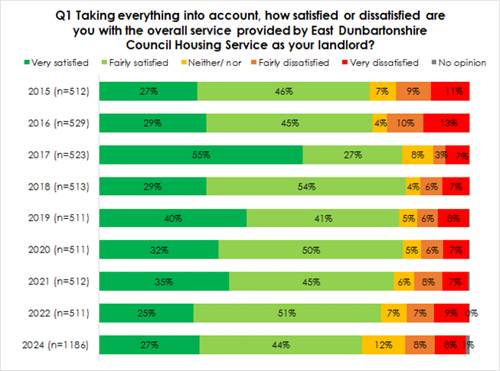
As can be seen from the chart below, overall satisfaction has seen a decreasing trend from 82% in 2020 to 79% in 2021 and to 76% in 2022 to 71% in 2024.
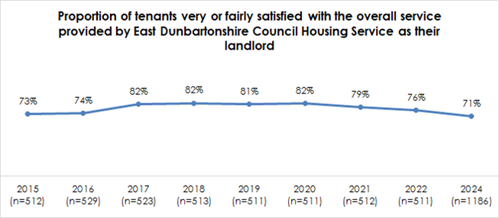
Analysis by key demographics reveals:
- Tenants aged 65 and over (77%) were more likely to be satisfied with the overall service provided than all other tenants (between 66% and 71% for the three other age groups).
- Households with children under the age of 16 were least likely to be satisfied with the overall service provided by their landlord (66%) while single adult households were most satisfied (73%).
- Those with tenancies of more than 10 years (72%) were more satisfied than tenants who had been a tenant of East Dunbartonshire for less than 3 years (69%) or between 3 and 10 years (68%).
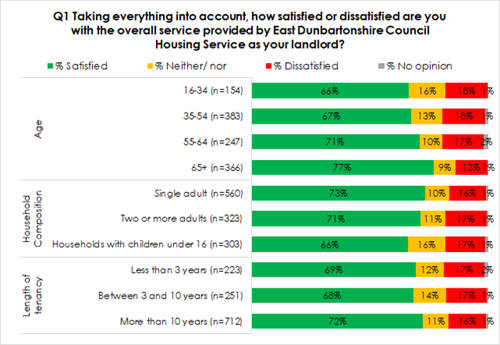
Reasons given for not being satisfied with overall service (Q2)
Respondents who were not satisfied with the overall service provided by the Council’s Housing Services were then asked to explain why this was. Tenants were most likely to say this was due to:
- Poor repairs service (36%),
- Poor customer service (21%).
- Home required upgrades/ improvements (16%).
Comparative analysis with the 2022 survey results reveals:
- The proportion of tenants who stated they were not happy due to poor repairs service has decreased from 55% in 2022 to 36% in 2024. This is the same as in 2021.
- The proportion of tenants who were unhappy with customer service has decreased from 28% in 2022 to 21% in 2024.
- More respondents said their home was in poor state of repair (increased from 12% in 2022 to 16% in 2024) and that the Council doesn’t listen or act on complaints (increased from 8% in 2022 to 12% in 2024).
Can you please explain why you said you were not satisfied with the overall landlord service provided by East Dunbartonshire Council Housing Services?
Sample size:
2017: 95
2018: 88
2019: 96
2020: 91
2021: 103
2022: 122
2024: 333
Poor repairs service, e.g. length of time to complete repairs/poor workmanship/not completed 1st time.
2017 - 43%
2018 - 50%
2019 - 46%
2020 - 50%
2021 - 36%
2022 - 55%
2024 - 36%
Poor customer service/staff unhelpful/don't return phone calls/lack of updates.
2017 - 23%
2018 - 24%
2019 - 15%
2020 - 34%
2021 - 18%
2022 - 28%
2024 - 21%
Home requiring upgrades/improvements.
2017 - 4%
2018 - 8%
2019 - 17%
2020 - 8%
2021 - 15%
2022 - 10%
2024 - 16%
Don't listen/act on our complaints/don't keep promises
2017 - 1%
2018 - 16%
2019 - 8%
2020 - 30%
2021 - 20%
2022 - 8%
2024 - 12%
Home in poor state of repair, e.g. dampness
2017 - 21%
2018 - 11%
2019 - 12%
2020 - 9%
2021 - 24%
2022 - 12%
2024 - 10%
Outside maintenance required, e.g. grass cutting/gardens
2017 - 7%
2018 - 16%
2019 - 4%
2020 - 2%
2021 - 6%
2022 - 5%
2024 - 6%
Problems with anti-social behaviour
2017 - 1%
2018 - 1%
2019 - 5%
2020 - 6%
2021 - 6%
2022 - 3%
2024 - 5%
Rent keeps increasing
N/A for previous years
2024 - 5%
Not had many dealings with them
N/A for previous years
2024 - 4%
Bins not being emptied
N/A for previous years
2021 - 5%
2022 - 2%
2024 - 2%
Other
2017 - 8%
2018 - 10%
2019 - 9%
2020 - 9%
2021 - 7%
2022 - 6%
2024 - 1%
Lack of communication (departments)
2017 - 2%
2018 - 1%
2019 - 1%
2020 - 1%
2021 - 0
2022 - 3%
2024 - 1%
Problems with close cleaning
2018 - 1%
2019 - 0
2020 - 2%
2021 - 1%
2022 - 2%
2024 - 1%
Poor appointment system/often don't turn up
2019 - 1%
2020 - 0
2021 - 0
2022 - 0
2024 - 0.3%
Communication and Participation
Communication sources (Q3)
Respondents were asked to state which sources of information they use to obtain information about the Council’s housing services. Tenants were most likely to state they use letters (47%) and newsletters (40%) to obtain information. These have been the top two sources of information used by tenants since 2017.
Q3 Which of the following sources of information do you use to obtain information about the Council's housing services?
Sample size:
2017: 523
2018: 513
2019: 511
2020: 511
2021: 512
2022: 511
2024: 1186
2024 By Age:
16-34: n=154
35-54: n=383
55-64: n=247
65+: n=366
Letters
2017 - 45%
2018 - 84%
2019 - 61%
2020 - 66%
2021 - 61%
2022 - 69%
2024 - 47% By Age 16-34:47%, 35-54: 45%, 55-64:42%, 65+:54%
Newsletters - Your Housing News
2017 - 47%
2018 - 83%
2019 - 79%
2020 - 85%
2021 - 59%
2022 - 50%
2024 - 40% By Age 16-34:22%, 35-54:37%, 55-64:47%, 65+: 46%
2017 - N/A
2018 - N/A
2019 - N/A
2020 - 2%
2021 - 22%
2022 - 26%
2024 - 23% By Age 16-34:39%, 35-54:29%, 55-64:18%, 65+:12%
Website
2017 - 9%
2018 - 11%
2019 - 16%
2020 - 15%
2021 - 6%
2022 - 9%
2024 - 11% By Age 16-34:18%, 35-54:16%, 55-64:13%, 65+:3%
Telephone
2017 - 8%
2018 - N/A
2019 - N/A
2020 - 2%
2021 - 5%
2022 - 3%
2024 - 9% By Age 16-34:5%, 35-54:6%, 55-64:11%, 65+:13%
2017 - N/A
2018 - 4%
2019 - 8%
2020 - 8%
2021 - 6%
2022 - 6%
2024 - 5% By Age 16-34:8%, 35-54:9%, 55-64:3%, 65+:2%
Other
2017 - 3%
2018 - 2%
2019 - 8%
2020 - 1%
2021 - 1%
2022 - 1%
2024 - 4% By Age 16-34:5%, 35-54:4%, 55-64:2%, 65+:5%
Don't know
2017 - 1%
2018 - 0%
2019 - 2%
2020 - 2%
2021 - 1%
2022 - 1%
2024 - 3% By Age 16-34:3%, 35-54:3%, 55-64:2%, 65+:3%
Text
N/A for previous years
2024 - 2% By Age 16-34:2%, 35-54:2%, 55-64:2%, 65+:2%
Meetings
2017 - 1%
2018 - 5%
2019 - 2%
2020 - 4%
2021 - 2%
2022 - 1%
2024 - 1% By Age 16-34:N/A, 35-54:1%, 55-64:1%, 65+:1%
2017 - N/A
2018 - 1%
2019 - 2%
2020 - 4%
2021 - 1%
2022 - 1%
2024 - 1% By Age 16-34:1%, 35-54:2%, 55-64:0.4%, 65+:0.3%
Surveys
2017 - 1%
2018 - 20%
2019 - 6%
2020 - 2%
2021 - 1%
2022 - 4%
2024 - 1% By Age 16-34:1%, 35-54:1%, 55-64:N/A, 65+:0.3%
QR Codes
N/A for previous years
2024 - 0.1% By Age 16-34:N/A, 35-54:0.3%, 55-64:N/A, 65+:N/A
Keeping tenants informed (Q4/5)
Just under 8 in 10 tenants (78%) said that the Council’s Housing Service was very or fairly good at keeping them informed about their services and decisions, compared to 12% who said neither good nor poor and 11% who felt the Council were very or fairly poor in this respect.

The proportion of tenants who felt the Council’s Housing Service was very or fairly good at keeping them informed about services and decisions has fluctuated over the years with satisfaction levels being highest in 2018 (92%) and lowest in 2024 (78%).

Further analysis by key demographics reveals:
- Older tenants aged 65 and over (83%) were most likely to state the Council’s Housing Services were very or fairly good at keeping them informed about services and decisions. Those aged under 54 were less positive (73%)
- Adult only households (79%) were more likely to state Housing Services were good in this respect than households with children under the age of 16 (74%).
- Respondents who had held their tenancy over 3 years (79%) were more likely to state Housing Services were very or fairly good in this respect than respondents with a tenancy of less than 3 years (72%).
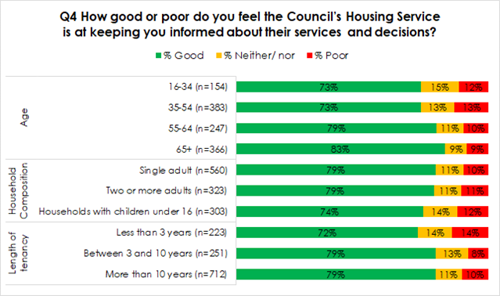
Tenants who felt the Council’s Housing Service were not good at keeping them informed about their services and decisions were then asked to explain why this was. Tenants were most likely to say this was because they are not kept informed generally (61%) or that they don’t feel they get enough information on repairs and property upgrades (16%). Encouragingly, phone calls not being returned or poor telephone service has decreased from 18% mentioning this as a source of dissatisfaction in 2022 to just 2% in 2024.
Q5 Can you please explain why you said that you feel East Dunbartonshire Council’s Housing Service are not good at keeping you informed about their services and decisions?
Sample size:
2017: 97
2018: 43
2019: 81
2020: 65
2021: 58
2022: 89
2024: 263
Want more information/ lack of information on repairs/ home upgrades
2017 - 12%
2018 - 19%
2019 - 19%
2020 - 31%
2021 - 21%
2022 - 48%
2024 - 16%
Don't feel they keep me updated/ I don't get any information on anything
2017 - 37%
2018 - 65%
2019 - 26%
2020 - 26%
2021 - 24%
2022 - 28%
2024 - 61%
Poor telephone service/ don't return calls/ follow up
2017 - 6%
2018 - 14%
2019 - 3%
2020 - 5%
2021 - 24%
2022 - 18%
2024 - 2%
Council does not keep their promises
2017 - 3%
2018 - N/A
2019 - 3%
2020 - 3%
2021 - 7%
2022 - N/A
2024 - N/A
Don't hear from them frequently enough
2017 - 8%
2018 - 2%
2019 - 5%
2020 - 3%
2021 - 2%
2022 - 1%
2024 - 3%
Only get newsletter from them
2017 - 3%
2018 - 5%
2019 - 3%
2020 - 3%
2021 - 9%
2022 - 5%
2024 - 2%
Not happy with newsletter e.g. not enough information, biased information, nothing of interest
2017 - 4%
2018 - N/A
2019 - 5%
2020 - 9%
2021 - 7%
2022 - 2%
2024 - 3%
Not enough information on the area
2017 - 2%
2018 - 5%
2019 - 22%
2020 - 3%
2021 - N/A
2022 - N/A
2024 - N/A
Don't respond to emails
2017 - 1%
2018 - N/A
2019 - N/A
2020 - N/A
2021 - 2%
2022 - 1%
2024 - 0.4%
Other
2017 - 20%
2018 - 12%
2019 - 9%
2020 - 2%
2021 - 3%
2022 - 2%
2024 - 3%
Can't comment/ don't know
2017 - 4%
2018 - 7%
2019 - 10%
2020 - 23%
2021 - 3%
2022 - 2%
2024 - 11%
Awareness of, and interest in participation opportunities (Q6)
Respondents were read a list of participation opportunities that tenants can be involved in to help improve the services provided from their landlord, and were asked to name the activities they were aware of. Please note that the wording of involvement in consultations has changed slightly.
The proportion of tenants who were aware of at least one activity has increased from 39% in 2022 to 47% in 2024.
Awareness was highest in terms of Open Days and Exhibitions (33%), customer comment cards at local post offices (26%), going along to the Tenants Participation Working Group (26%), being part of a focus group to look at a particular area of service (29%), answering customer satisfaction questionnaires (27%) and becoming a member of a Registered Tenants and Residents Organisation/ coming along to the Tenant Participation Working Group (both 26%).
Q6(a) Are you aware of the following ways in which you could become involved in East Dunbartonshire Council’s Housing Service to help improve their services?
Sample size:
2017: 523
2018: 513
2019: 511
2020: 511
2021: 512
2022: 511
2024: 1186
None
2017 - 38%
2018 - 15%
2019 - 29%
2020 - 39%
2021 - 36%
2022 - 39%
2024 - 47%
Open Days and Exhibitions
2017 - 43%
2018 - 54%
2019 - 48%
2020 - 43%
2021 - 30%
2022 - 26%
2024 - 33%
Being part of a focus group to look at a particular area of service
2017 - 34%
2018 - 12%
2019 - 32%
2020 - 33%
2021 - 19%
2022 - 18%
2024 - 29%
Answering customer satisfaction questionnaires
2017 - 42%
2018 - 56%
2019 - 42%
2020 - 34%
2021 - 28%
2022 - 33%
2024 - 27%
Becoming a member of a Registered Tenants and Residents Organisation
2017 - 47%
2018 - 64%
2019 - 31%
2020 - 35%
2021 - 30%
2022 - 25%
2024 - 26%
Going along to the Tenants Participation Working Group
2017 - 37%
2018 - 25%
2019 - 25%
2020 - 33%
2021 - 18%
2022 - 26%
2024 - 26%
Customer comment cards at community hubs
2017 - 35%
2018 - 26%
2019 - 34%
2020 - 27%
2021 - 24%
2022 - 22%
2024 - 22%
Online questionnaires
2017 - 36%
2018 - 13%
2019 - 31%
2020 - 19%
2021 - 18%
2022 - 22%
2024 - 22%
Answering feedback questionnaires or surveys on specific issues such as consultation on rents/ Giving feedback on specific issues such as consultation on rents and local housing strategy (2024)
2017 - 45%
2018 - 57%
2019 - 19%
2020 - 26%
2021 - 23%
2022 - 12%
2024 - 20%
Being part of Tenant Scrutiny Group who carry out customer led inspections to scrutinise a particular area of the housing service
2017 - 32%
2018 - 13%
2019 - 14%
2020 - 17%
2021 - 8%
2022 - 16%
2024 - 19%
Being on a list interested tenants
2017 - 34%
2018 - 14%
2019 - 18%
2020 - 20%
2021 - 10%
2022 - 11%
2024 - 16%
Using the same list, respondents were then asked which they would be interested in participating in. Almost 1 in 5 tenants (17%) stated they would be interested in participating in at least one activity. This is just marginally lower than in 2022 and 2021 when 23% and 20% respectively said they would be interested in participating in at least one activity.
Tenants were most likely to be interested in answering customer satisfaction questionnaires (11%), answering online questionnaires (9%), giving feedback on specific issues such as consultation on rents and local housing strategy (7%) and being part of a focus group to look at a particular area of service (7%).
Q6(b) Whether or not you have participated in these activities in the past, would you be interested in participating in any of these in the future to help the Council improve their housing services?
Sample size:
2017: 523
2018: 513
2019: 511
2020: 511
2021: 512
2022: 511
2024: 1186
Answering customer satisfaction questionnaires
2017 - 4%
2018 - 45%
2019 - 26%
2020 - 13%
2021 - 13%
2022 - 12%
2024 - 11%
Online questionnaires / Online questionnaires through email and QR codes (2024)
2017 - 4%
2018 - 2%
2019 - 13%
2020 - 8%
2021 - 5%
2022 - 6%
2024 - 9%
Answering feedback questionnaires or surveys on specific issues such as consultation on rents / Giving feedback on specific issues such as consultation on rents and local housing strategy (2024)
2017 - 4%
2018 - 48%
2019 - 20%
2020 - 15%
2021 - 9%
2022 - 4%
2024 - 7%
Being part of a focus group to look at a particular area of service
2017 - 4%
2018 - 3%
2019 - 8%
2020 - 7%
2021 - 3%
2022 - 4%
2024 - 7%
Going along to the Tenants Participation Working Group
2017 - 4%
2018 - 3%
2019 - 8%
2020 - 7%
2021 - 3%
2022 - 6%
2024 - 6%
Open Days and Exhibitions
2017 - 4%
2018 - 4%
2019 - 8%
2020 - 7%
2021 - 4%
2022 - 3%
2024 - 5%
Becoming a member of a Registered Tenants and Residents Organisation
2017 - 5%
2018 - 6%
2019 - 8%
2020 - 6%
2021 - 4%
2022 - 5%
2024 - 5%
Customer comment cards at community hubs
2017 - 4%
2018 - 3%
2019 - 12%
2020 - 7%
2021 - 4%
2022 - 4%
2024 - 5%
Being on a list interested tenants
2017 - 4%
2018 - 3%
2019 - 9%
2020 - 6%
2021 - 3%
2022 - 2%
2024 - 5%
Carry out customer led inspections to scrutinise a particular area of the housing service
2017 - 4%
2018 - 2%
2019 - 8%
2020 - 6%
2021 - 2%
2022 - 3%
2024 - 4%
None
2017 - 94%
2018 - 42%
2019 - 67%
2020 - 77%
2021 - 80%
2022 - 77%
2024 - 83%
Further analysis by age showed that younger respondents were much more likely to be interested in participating than older respondents, for example, 27% of those aged 16-34 and 21% of those aged 35-54 were interested in participating compared to 10% of those aged 65+.
Moreover, younger respondents were more likely to be interested in engaging in online questionnaires, with 16% of respondents aged 16-34 and 13% of those aged 35-54 saying they were interested in this compared to 4% of those aged 65+.
Reasons for not becoming more involved in the Council’s Housing Service (Q7)
When asked what stops them participating more with the Council’s Housing service, tenants were most likely to say that they simply were not interested in participating more (38%) or name health and disability issues (26%) or work commitments (15%) as reasons that stop them becoming more involved with the Council’s Housing Service. These were also the top three reasons mentioned in previous years.
Q7 What, if anything, stops you participating more with the Council’s Housing Service?
Sample size:
2017: 523
2018: 513
2019: 511
2020: 511
2021: 512
2022: 511
2024: 1186
Not interested
2017 - 42%
2018 - 27%
2019 - 27%
2020 - 28%
2021 - 41%
2022 - 46%
2024 - 38%
Health / disability issues
2017 - 27%
2018 - 31%
2019 - 37%
2020 - 34%
2021 - 27%
2022 - 25%
2024 - 26%
Work commitments
2017 - 14%
2018 - 26%
2019 - 23%
2020 - 18%
2021 - 17%
2022 - 11%
2024 - 15%
Childcare commitments
2017 - 10%
2018 - N/A
2019 - 12%
2020 - 7%
2021 - 11%
2022 - 9%
2024 - 8%
Other
2017 - 16%
2018 - 4%
2019 - 9%
2020 - 4%
2021 - 4%
2022 - 3%
2024 - 8%
Not aware of any meetings / opportunities to participate
2017 - 6%
2018 - 3%
2019 - 9%
2020 - 7%
2021 - 5%
2022 - 9%
2024 - 6%
Nothing, I already participate
2017 - 3%
2018 - 4%
2019 - 5%
2020 - 8%
2021 - 3%
2022 - 6%
2024 - 6%
Don’t have anything to contribute
2017 - 8%
2018 - 2%
2019 - 1%
2020 - 3%
2021 - 3%
2022 - 2%
2024 - 2%
Don’t understand enough about work of the councils housing services
2017 - 4%
2018 - 0%
2019 - 2%
2020 - N/A
2021 - 0%
2022 - 2%
2024 - 1%
Lack of confidence speaking up
2017 - 3%
2018 - 2%
2019 - 3%
2020 - 2%
2021 - 2%
2022 - 1%
2024 - 1%
Transport issues
2017 - 1%
2018 - 2%
2019 - 2%
2020 - 1%
2021 - 1%
2022 - 0%
2024 - 0%
Satisfaction with participation opportunities (Q8/9)
Just under 9 in 10 respondents (88%) were very or fairly satisfied with the opportunities given to them to participate in the Council’s Housing Services decision-making processes. 10% were neither satisfied nor dissatisfied and 3% were either very or fairly dissatisfied.
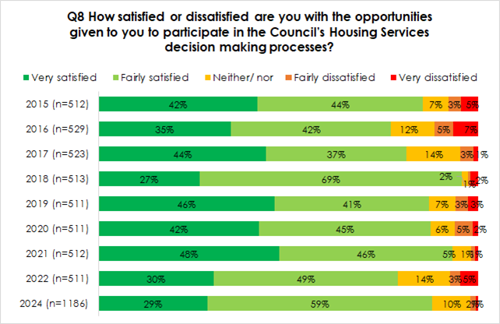
The proportion of tenants satisfied with the opportunities given to them to participate in decision-making processes has increased to 88% in 2024, rising from 79% in 2022. However remains lower than the 93% reported in 2021.
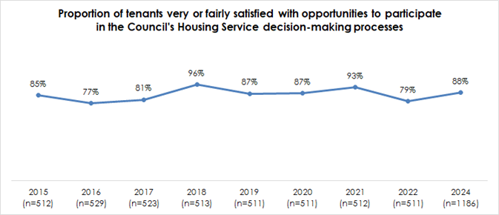
Analysis of satisfaction levels with opportunities to participate by key demographics reveals that satisfaction is not significantly different across most demographic factors. We see the greatest difference by age where those aged 65+ were more likely to be positive about the opportunities to participate (91%) than those aged 35 -54 (85%) and those aged 16-34 (86%).
Overall satisfaction does not vary significantly by length of tenancy or household composition.

Tenants who were not satisfied with the opportunities given to them to participate in their landlord’s decision-making processes were then asked to explain why this was. Tenants were most likely to say this was due to being unaware of or not having enough information about the opportunities available (38%), followed by not being sure or not knowing why they were not satisfied (20%) or simply that they were not interested (18%). These comments were more likely to be made by those that stated they were neither satisfied nor dissatisfied than those who were dissatisfied with the opportunities to participate in decision making.
Q9 You said you are not satisfied with the opportunities given to you to participate in the Council’s Housing Services decision making processes. Can you explain why you said that?
Sample size
2017: 100
2018: 22
2019: 67
2020: 64
2021: 35
2022: 108
2024: 144
Don't know much about it/ what opportunities are available/ don't inform us of anything
2017 - 14%
2018 - 68%
2019 - 43%
2020 - 36%
2021 - 60%
2022 - 44%
2024 - 38%
Not interested
2017 - 18%
2018 - N/A
2019 - 24%
2020 - 22%
2021 - N/A
2022 - 7%
2024 - 18%
Don't get opportunities to participate
2017 - 29%
2018 - 18%
2019 - 5%
2020 - 19%
2021 - 6%
2022 - 28%
2024 - 6%
Not sure/ don't know
2017 - 16%
2018 - N/A
2019 - 10%
2020 - 14%
2021 - 20%
2022 - 6%
2024 - 20%
No point - don't do what they say they will/ don't listen/ poor communication/ follow up
2017 - 11%
2018 - 14%
2019 - 16%
2020 - 9%
2021 - 11%
2022 - 14%
2024 - 15%
Not able to participate due to ill health/ old age/ housebound
2017 - 4%
2018 - 5%
2019 - N/A
2020 - 3%
2021 - 3%
2022 - N/A
2024 - 2%
Other
2017 - 8%
2018 - 18%
2019 - 2%
2020 - N/A
2021 - N/A
2022 - 1%
2024 - 1%
Satisfaction with Housing Services listening to views and acting upon them (Q10)
A new question was introduced in the 2021 survey, which asked tenants how satisfied or dissatisfied they were with how the Council’s Housing Service listens to their views and acts upon them in the monitoring and development of services. Just under two thirds of respondents in 2024 (64%) were very or fairly satisfied in this respect, compared to 20% who were neither satisfied nor dissatisfied and 17% who were very or fairly dissatisfied. Overall satisfaction has seen a decrease from 74% in 2021 and 68% in 2022.
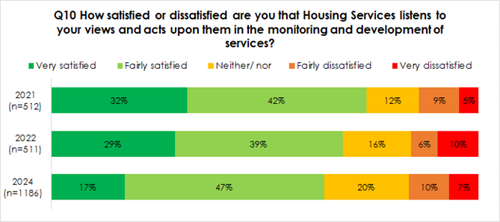
Analysis by key demographics reveals respondents who were aged 65 and over were most likely to be satisfied in this respect (72%), as were households with 2 or more adults (67%) and those who had lived in their home for less than 3 years (66%).
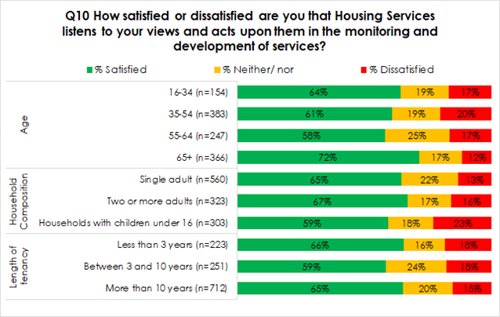
The Repair And Maintenance Of Your Home
Awareness of responsibilities for the home (Q11)
The vast majority of tenants were aware of their own responsibilities as a tenant in relation to the maintenance of their home (95%) and the Council’s responsibilities in relation to the maintenance of their home (90%). The proportion of tenants aware of their own responsibilities as a tenant has decreased from 98% in 2021 to 93% in 2022 but has now risen slightly to 95% in 2024.
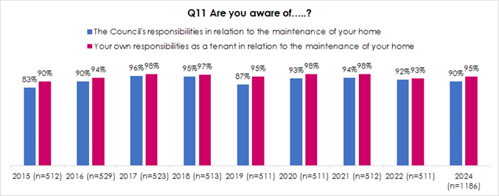
Satisfaction when dealing with repairs (Q12)
All tenants surveyed were asked about their satisfaction with the way the housing service deal with repairs, 65% were very or fairly satisfied in this respect, compared to 11% who were neither satisfied nor dissatisfied and 24% who were very or fairly dissatisfied.

NB percentages referred to in text as combined satisfaction or dissatisfaction differ from the sum of percentages in the chart due to rounding.
Satisfaction with the repairs service has seen a downward trend from the 83% reported in 2019 to 77% in 2020, to 71% in 2021 and to 65% in 2022. This has remained consistent in 2024 at 65%.

Suggestions for improvement to the repairs service (Q13)
Respondents who were not satisfied with the way the Housing Service deals with repairs and maintenance were asked if they had any suggestions for improvement. Where a suggestion was provided, this was most likely to be in relation to quicker timescales to start and complete repairs (59%) and improvements to customer service (17%) and improving quality of workmanship/ complete on first visit (16%).
Q13 What, if anything, could have been done to improve the repairs process?
Sample size
2017: 516
2018: 294
2019: 225
2020: 229
2021: 190
2022: 246
2024: 413
Nothing/ none
2017 - 47%
2018 - 61%
2019 - 69%
2020 - 62%
2021 - 52%
2022 - 50%
2024 - 7%
Quicker time to start/ complete repairs
2017 - 12%
2018 - 17%
2019 - 9%
2020 - 14%
2021 - 14%
2022 - 21%
2024 - 59%
Improve the quality of workmanship/ complete on first visit
2017 - 6%
2018 - 12%
2019 - 6%
2020 - 9%
2021 - 10%
2022 - 9%
2024 - 16%
Better appointment system e.g. tradesman turning up on time/ telephone if late/ specific time slots
2017 - 6%
2018 - 1%
2019 - 2%
2020 - 6%
2021 - 3%
2022 - 2%
2024 - 4%
Improve customer service e.g. staff more helpful when reporting repair/ listen to what we say/return phone calls
2017 - 1%
2018 - 6%
2019 - 4%
2020 - 4%
2021 - 10%
2022 - 11%
2024 - 17%
Better communication between departments e.g. office staff and tradesmen
2017 - 3%
2018 - 1%
2019 - 2%
2020 - 4%
2021 - 2%
2022 - 2%
2024 - 3%
Other
2017 - 1%
2018 - 1%
2019 - 1%
2020 - 4%
2021 - 3%
2022 - 2%
2024 - 0%
Tradesmen to clean up mess/ be more friendly/better attitude
2017 - 1%
2018 - 0%
2019 - 1%
2020 - 3%
2021 - 1%
2022 - 1%
2024 - 0%
Replace rather than repair e.g. new windows
N/A for previous years
2020 - 2%
2021 - 4%
2022 - 0%
2024 - 2%
Happy with the repair service
2017 - 2%
2018 - 7%
2019 - 3%
2020 - 2%
2021 - 3%
2022 - 5%
2024 - N/A
Follow up on work completed/ keep us informed about progress
2017 - 2%
2018 - 0%
2019 - 2%
2020 - 1%
2021 - 4%
2022 - 3%
2024 - 1%
Don't know
2017 - 23%
2018 - 4%
2019 - 3%
2020 - 1%
2021 - 3%
2022 - 1%
2024 - 4%
Quality of the home (Q14/15)
The majority of respondents (78%) were very or fairly satisfied with the quality of their home compared to 9% who were neither satisfied nor dissatisfied and 13% who were either very or fairly dissatisfied.
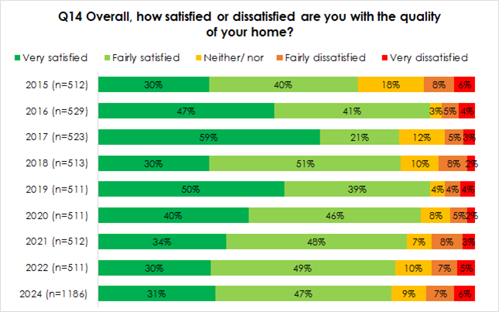
Overall satisfaction with the quality of the home has not changed significantly since 2022 when 79% of respondents were satisfied with the quality of their home. However, satisfaction in this respect has been decreasing since 2019 (88%).
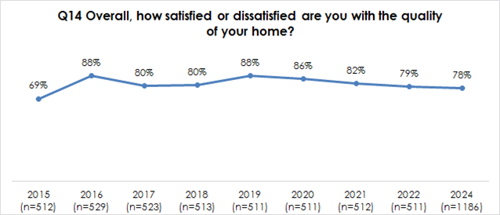
Further analysis by key demographics reveals the following:
- Older tenants aged 65 and over were most satisfied with the quality of their home (88%), while tenants aged 16-34 were least satisfied (65%).
- Tenants who lived in a household with one adult (81%) or two or more adults (80%) were more likely to be satisfied with the quality of the home than tenants who lived in a household with children (69%).
- Those that had lived in their home for more than 10 years were most satisfied with the quality of their home (82%).
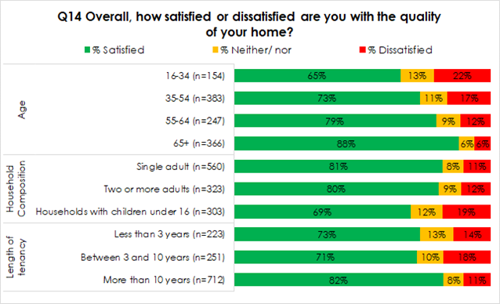
Analysis by area reveals varying degrees of satisfaction with the quality of the home. Those who lived in Campsie Glen (100%, 3 tenants) and Balmore (100%, 1 tenant) were most satisfied whereas tenants who lived in Torrance (71%) and Milngavie (73%) were least satisfied. Due to very low base numbers, the results of this analysis should be treated with caution.
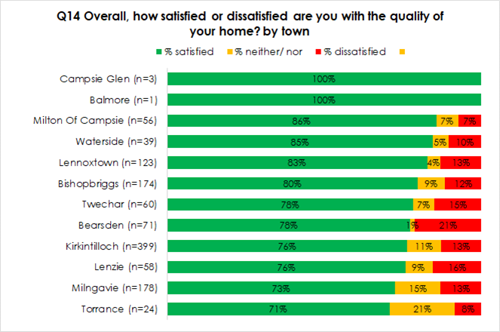
Tenants who stated they were not satisfied with the quality of their home were then asked to explain why they felt this way. Tenants were most likely to say this was due to their home requiring upgrades and improvement (37%), that their home has outstanding repairs (38%).
Q15 You said you were not satisfied with the overall quality of your home. Can you please explain why?
Sample size
2017: 100
2018: 101
2019: 61
2020: 73
2021: 93
2022: 108
2024: 263
Home requires upgrades/ improvements e.g. windows/ bathroom/ kitchen
2017 - 34%
2018 - 73%
2019 - 43%
2020 - 45%
2021 - 55%
2022 - 66%
2024 - 37%
Problems with dampness/ condensation/mould
2017 - 15%
2018 - 12%
2019 - 8%
2020 - 23%
2021 - 25%
2022 - 15%
2024 - 22%
Home in poor state of repair/ repairs required
2017 - 46%
2018 - 9%
2019 - 38%
2020 - 19%
2021 - 33%
2022 - 32%
2024 - 38%
Appearance of outside building e.g. painted/rough casting
2017 - 6%
2018 - 9%
2019 - 5%
2020 - 15%
2021 - 5%
2022 - 9%
2024 - 3%
Poor heating/ boiler system
2017 - 1%
2018 - 15%
2019 - 2%
2020 - 14%
2021 - 14%
2022 - 6%
2024 - 3%
Outside maintenance required e.g. roof/garden/ gutters
2017 - 15%
2018 - 13%
2019 - 7%
2020 - 8%
2021 - 7%
2022 - 16%
2024 - 3%
Other
2017 - 12%
2018 - 9%
2019 - 3%
2020 - 8%
2021 - 4%
2022 - 7%
2024 - 4%
Issues with improvements e.g. new window sare draughty/ no soundproofing
N/A for previous years
2020 - 7%
2021 - 8%
2022 - 3%
2024 - 2%
Maintenance of communal areas e.g. close painting
N/A for previous years
2020 - 3%
2021 - 1%
2022 - N/A
2024 - 2%
Satisfaction with aspects of the home (Q16)
All respondents were then asked how satisfied or dissatisfied they were with various aspects of their home. Satisfaction was high, ranging from 74% with regards to the kitchen and external appearance of the building to 85% with regards to the heating system.

Satisfaction levels with regards to all aspects of the home have not changed significantly since the 2022 survey.
Q16 How satisfied are you with the following aspects of your home? (% very or fairly satisfied)
Sample size
2017: 523
2018: 513
2019: 511
2020: 511
2021: 512
2022: 511
2024: 1186
Heating System
2017 - 91%
2018 - 89%
2019 - 92%
2020 - 89%
2021 - 88%
2022 - 86%
2024 - 85%
General condition of your property overall
2017 - 88%
2018 - 84%
2019 - 85%
2020 - 88%
2021 - 82%
2022 - 82%
2024 - 81%
The Kitchen
2017 - 84%
2018 - 81%
2019 - 76%
2020 - 75%
2021 - 76%
2022 - 74%
2024 - 73%
The Bathroom
2017 - 83%
2018 - 80%
2019 - 72%
2020 - 81%
2021 - 73%
2022 - 76%
2024 - 78%
External appearance of the building
2017 - 82%
2018 - 83%
2019 - 72%
2020 - 76%
2021 - 76%
2022 - 75%
2024 - 73%
Windows
2017 - 79%
2018 - 85%
2019 - 80%
2020 - 82%
2021 - 80%
2022 - 77%
2024 - 75%
Neighbourhood Management
Satisfaction with contribution to the management of the neighbourhood (Q17/18)
Just under 8 in 10 tenants (78%) were very or fairly satisfied with the Council’s Housing Services contribution to the management of the neighbourhood they live in. This is compared to 9% who were neither satisfied nor dissatisfied and 13% who were very or fairly dissatisfied.
The proportion of tenants very or fairly satisfied with their landlord’s contribution to the management of the neighbourhood they live in has fluctuated marginally over recent years, with satisfaction being highest in 2019 (88%) and lowest in 2015 (69%).
Analysis by key demographics shows:
- Respondents who have been a tenant for between more than 10 years were slightly more likely to be satisfied in this respect (75%) than tenants who have held their tenancy for less than 3 years (70%).
- Older respondents aged 65+ were most likely to be satisfied with contribution to the management of the neighbourhood (78%) and those aged 16-34 were less satisfied (68%).
- There were not significant differences noted by household composition.
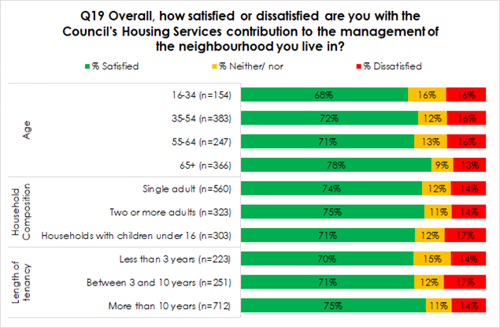
Analysis by area reveals varying degrees of satisfaction with the Council’s Housing Services contribution to the management of the neighbourhood. As can be seen from the chart below, the majority of tenants in each area were very or fairly satisfied in this respect, with satisfaction levels ranging from 69% for those living in Lennoxtown to 100% of tenants living in Campsie Glen and Torrance.
Due to very low base numbers for certain areas, the results of this analysis should be treated with caution.
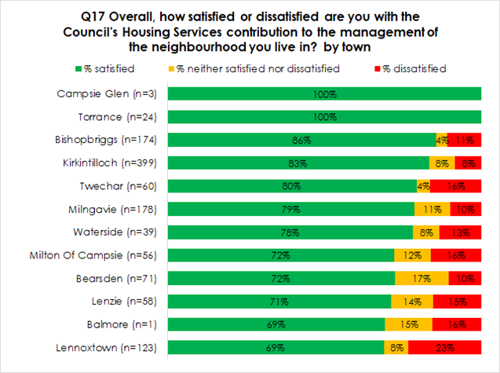
The most common reasons given for not being satisfied with the Council’s Housing Service’s contribution to the management of the neighbourhood were tenants stating the Council do nothing in the area (25%), followed by poor landscape maintenance (17%) and regarding issues with communal spaces e.g. stairwell/ bin areas (11%).
Q18 You said you were not satisfied with the Council’s Housing Service’s contribution to the management of the neighbourhood you live in. Can you please explain why?
Sample size
2017: 83
2018: 71
2019: 71
2020: 114
2021: 90
2022: 105
2024: 314
The Council don't do anything/ don't see anything getting done/ no visibility
2017 - 23%
2018 - 16%
2019 - 21%
2020 - 25%
2021 - 21%
2022 - 33%
2024 - 25%
Litter/ rubbish issues/ area is dirty/ rundown
2017 - 10%
2018 - 17%
2019 - 7%
2020 - 14%
2021 - 18%
2022 - 14%
2024 - 8%
Anti-social behaviour issues
2017 - 21%
2018 - 23%
2019 - 22%
2020 - 13%
2021 - 14%
2022 - 11%
2024 - 19%
Road / pavements e.g. not gritted in icy weather / too many potholes
2017 - 4%
2018 - 7%
2019 - 9%
2020 - 11%
2021 - 7%
2022 - 7%
2024 - 3%
Poor landscape maintenance e.g. grass cutting/ bushes/ hedges
2017 - 16%
2018 - 13%
2019 - 23%
2020 - 9%
2021 - 20%
2022 - 20%
2024 - 17%
Exterior look/ appearance of properties e.g. need painted/ cleaned/ fences fixed
2017 - 5%
2018 - 6%
2019 - 6%
2020 - 9%
2021 - 18%
2022 - 7%
2024 - 3%
Other
2017 - 11%
2018 - 14%
2019 - 14%
2020 - 8%
2021 - 8%
2022 - 1%
2024 - 1%
Problem with dog fouling
2017 - 5%
2018 - 1%
2019 - 10%
2020 - 7%
2021 - 2%
2022 - 4%
2024 - 7%
Gardens are unkept/ neighbours don't look after property
N/A for previous years
2020 - 5%
2021 - 9%
2022 - 1%
2024 - 5%
Don't know/ No comment
N/A for previous years
2020 - 4%
2021 - N/A
2022 - N/A
2024 - 9%
Bin issues e.g. Not emptied / Need more / Left on street
2017 - N/A
2018 - 3%
2019 - N/A
2020 - 3%
2021 - N/A
2022 - 11%
2024 - 9%
Need to vet tenants
2018 - 14%
2019 - 2%
2020 - 2%
2021 - 6%
2022 - 3%
2024 - 1%
Issues with communal spaces e.g. stairwell/bin areas
Problems with parking
N/A for previous years
2020 - 2%
2021 - 6%
2022 - 10%
2024 - 11%
Problems with parking
2017 - 7%
2018 - 3%
2019 - 7%
2020 - 1%
2021 - 1%
2022 - 2%
2024 - 2%
Satisfaction with the way the Council’s Housing Services deals with anti-social behaviour (Q19-22)
All respondents were asked how satisfied they were with the way the Council’s Housing Services deals with anti-social behaviour. As can be seen from the chart below, just over a half of tenants answered don’t know (54%), while 31% were very or fairly satisfied, 7% were neither satisfied nor dissatisfied, 8% were very or fairly dissatisfied.
Analysis of tenants who provided an answer (e.g. excluding those who answered ‘don’t know’) shows that 67% were very or fairly satisfied, 16% were neither satisfied nor dissatisfied and 18% were very or fairly dissatisfied.
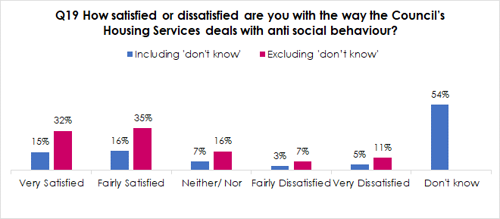
Compared to 2022, the overall proportion of tenants who had an opinion on the way the Council’s Housing Service deals with anti-social behaviour has not changed, remaining at 67% satisfied.
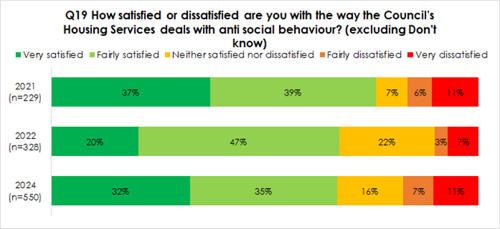
Just over 1 in 10 respondents (14%) had experienced anti-social behaviour on their estate during the last 12 months. This has not changed from 2022 when 14% of respondents had experienced anti-social behaviour on their estate in the last 12 months.
Of these respondents, 70% reported this anti-social behaviour to the Council. This is an increase compared to 2022 when 64% who had experienced anti-social behaviour reported this to the Council.

As can be seen below, 36% of tenants who had experienced anti-social behaviour within the last 12 months were very or fairly dissatisfied with the way the Council’s Housing Services deals with anti-social behaviour, compared to 78% of tenants who did not experience anti-social behaviour. Please note that those who stated ‘don’t know’ have been excluded from this analysis as a significant number of those who had not experienced anti-social behaviour stated don’t know.
Q19How satisfied or dissatisfied are you with the way the Council’s Housing Services deals with anti
social behaviour?
Q20 Have you experienced any anti- social behaviour on your estate during the last 12 months? (excluding don't know)
Yes (n=144)
Very satisfied - 8%
Fairly satisfied - 28%
Neither satisfied nor dissatisfied - 15%
Fairly dissatisfied - 19%
Very dissatisfied - 30%
No (n=40)
Very satisfied - 41%
Fairly satisfied - 37%
Neither satisfied nor dissatisfied - 16%
Fairly dissatisfied - 3%
Very dissatisfied - 4%
Just over a third of tenants (34%) who reported an incident of anti-social behaviour to the Council’s Housing Services were very or fairly satisfied with how Housing Service’s deals with anti-social behaviour, compared to 42% of tenants who did not report this. Again, don’t know responses have been excluded from this analysis.
Q19 How satisfied or dissatisfied are you with the way the Council’s Housing Services deals with anti social behaviour?
Q21 Did you report this anti-social behaviour to the Council? (excluding don't know)
Yes (n=106)
Very satisfied - 8%
Fairly satisfied - 26%
Neither satisfied nor dissatisfied - 13%
Fairly dissatisfied - 20%
Very dissatisfied - 33%
No (n=38)
Very satisfied - 11%
Fairly satisfied - 32%
Neither satisfied nor dissatisfied - 18%
Fairly dissatisfied - 18%
Very dissatisfied - 21%
Respondents who reported anti-social behaviour to the Council during the last 12 months were asked how satisfied they were with the way the Council dealt with their report of anti-social behaviour. Overall, 29% were very or fairly satisfied with the way in which the Council dealt with their report, 7% were neither satisfied nor dissatisfied and 55% were very or fairly dissatisfied. Overall satisfaction was 23% in 2021 and 24% in 2022 therefore there is an improving picture of satisfaction with the way the Council is dealing with specific anti-social behaviour complaints.
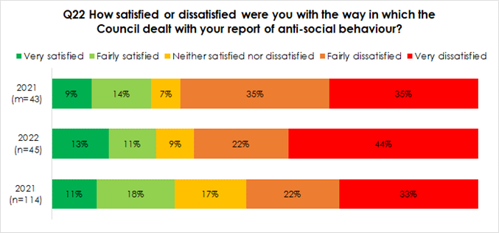
One third of tenants (33% or 37 tenants) who reported anti-social behaviour stated the actions of the Council contributed to a reduction in the incidence of anti-social behaviour, while 67% (77 tenants) said it did not. This is exactly the same as in 2022 when 33% of respondents who had reported anti-social behaviour to the Council said the actions of the Council contributed to a reduction in the incidence of anti-social behaviour.
The table below shows that just 9% of tenants who stated the Council’s contribution did not lead to a reduction in the incidence of anti-social behaviour were satisfied with how the Council dealt with their report. Conversely, where tenants had seen a reduction in the incidence of anti-social behaviour they were more likely to be satisfied with the way the Council dealt with their report of anti-social behaviour (71%).
Q22 How satisfied or dissatisfied were you with the way in which the Council dealt with your report of anti-social behaviour?
Q23 Did the action of the Council contribution to a reduction in the incidence of anti-social behaviour?
Yes (n=37)
Very satisfied - 30%
Fairly satisfied - 41%
Neither satisfied nor dissatisfied - 14%
Fairly dissatisfied - 11%
Very dissatisfied - 5%
No (n=77)
Very satisfied - 1%
Fairly satisfied - 8%
Neither satisfied nor dissatisfied - 18%
Fairly dissatisfied - 27%
Very dissatisfied - 46%
Tenants who reported anti-social behaviour to the Council’s Housing Services were asked to provide further feedback on the way their complaint was dealt with and how the situation has changed. Tenants were most likely to say that the Council did not do anything/ did not help (47%).
Q24 Can you provide any further feedback on the way your anti-social behaviour complaint was dealt with and how the situation has changed?
| Base: All who reported ASB, n=114 | No. | % |
|---|---|---|
|
The Council didn't do anything/ did not help |
54 |
47% |
|
The Council resolved the issue |
24 |
21% |
|
The issue is ongoing |
10 |
9% |
|
Other |
10 |
9% |
|
I had to get the police involved |
9 |
8% |
|
The Council intervened but the issue is not resolved |
7 |
6% |
|
The problem was resolved between neighbours/ itself |
1 |
1% |
Rent And Value For Money
Value for money (Q25/26)
Just under over three quarters of tenants (76%) said that the rent for their property represents very or fairly good value for money, compared to 14% who felt it represented neither good nor poor value and 10% who felt it represented very or fairly poor value for money.

As can be seen from the chart below, the proportion of tenants who think the rent for their property represents very or fairly good value for money has decreased marginally year on year since 2020 when 82% of tenants said they felt their rent represented good value for money.
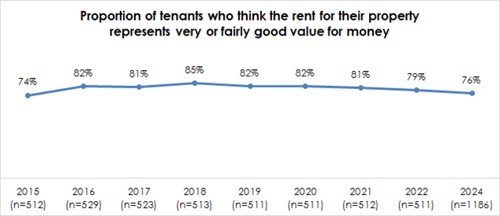
Analysis by key demographics reveals the following:
- As age increases, the proportion of tenants who feel their rent represents good value for money increases, from 73% of tenants aged 16-34 to 81% of tenants aged 65 and over,
- Households with children were least likely to be positive with respect to their view of value for money (71%).
- There were only marginal differences noted with respect to value for money and length of tenancy.
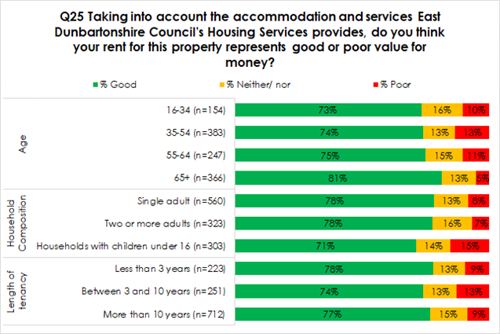
Further analysis reveals tenants who receive full housing benefit, or Universal Credit that covers part rent (80%) were more likely to say their rent represents good value for money whereas tenants who pay full rent (71%) were least likely to say their rent represents good value for money.
Tenants who said that their rent did not represent good value for money were asked to explain why this was. Tenants were most likely to say they felt the rent was too expensive or increases too often (42%), or where they did not believe it was good value for money due to the quality/ condition of their home (24%).
Q26 You said you felt that your rent does not represent good value for money, can you please explain why?
Sample size:
2017 - 98
2018 - 78
2019 - 91
2020 - 90
2021 - 97
2022 - 108
2024 - 280
Too expensive/ keeps increasing
2017 - 34%
2018 - 31%
2019 - 41%
2020 - 44%
2021 - 36%
2022 - 34%
2024 - 42%
Poor quality/ condition of home
2017 - 13%
2018 - 50%
2019 - 13%
2020 - 27%
2021 - 35%
2022 - 18%
2024 - 24%
Not good value for money/ poor service received
2017 - 11%
2018 - 12%
2019 - 14%
2020 - 20%
2021 - 34%
2022 - 32%
2024 - 11%
I receive full housing benefit
2017 - 20%
2018 - N/A
2019 - 4%
2020 - 8%
2021 - 3%
2022 - N/A
2024 - 4%
Nothing gets done e.g. repairs/ maintenance
2017 - 9%
2018 - 14%
2019 - 13%
2020 - 6%
2021 - 6%
2022 - 19%
2024 - 13%
Don't know
2017 - 12%
2018 - 10%
2019 - 10%
2020 - 6%
2021 - 4%
2022 - 7%
2024 - 8%
It is fine/ ok
N/A for previous years
2022 - 7%
2024 - 8%
Housing benefit (Q27)
Just under half of tenants who responded (45%) were in receipt of housing benefit (40% full and 5% partial), 18% of tenants are in receipt of Universal Credit (13% that covers full rent and 5% which covers part of the rent payment) and 38% of tenants do not receive housing benefit and pay full rent. The proportion of tenants in receipt of full housing benefit has decreased since 2022 (by 5 percentage points).

Affordability of rent payments (Q28)
Tenants who pay either full or partial rent payments were asked how easy they find it to afford their rent payments. Half of tenants (50%) said they find their rent payments very or fairly easy to afford, compared to 40% who find them just about affordable and 10% who find them very or fairly difficult to afford.
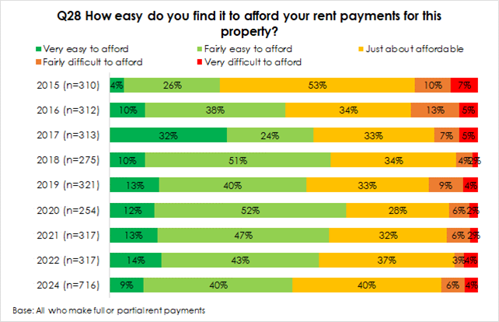
NB percentages referred to in text as combined satisfaction or dissatisfaction differ from the sum of percentages in the char t due to rounding.
As can be seen below, the proportion of respondents who found rent payments easy to afford has decreased from 64% in 2020 to 60% in 2021, 57% in 2022 and again to 50% in 2024.
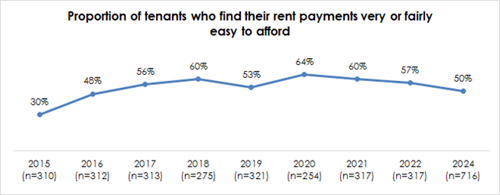
The results to this question do not vary significantly by age, however, analysis by household composition shows that single adult households (48%) and households with children (49%) were slightly less likely to state their rent was easy to afford than households with two or more adults (52%.
Analysis by length of tenancy shows that tenants who have had their tenancy for less than three years were less likely to feel their rent was easy to afford (43%) than those who had their tenancy for a greater length of time.

Other Comments
Other comments about the landlord and its services (Q33)
Finally, tenants were asked if they had any further comments about their landlord and the services provided. Almost three quarters of tenants (74%) did not provide any further comment. Where a comment was provided, this was most likely to be tenants expressing that they were happy with their landlord and the services provided (5%).
Q29 Do you have any other comments you wish to make about your landlord and its services?
Sample size
2017 - 523
2018 - 513
2019 - 511
2020 - 511
2021 - 512
2022 - 511
2024 - 1186
No other comments
2017 - 72%
2018 - 59%
2019 - 72%
2020 - 67%
2021 - 68%
2022 - 68%
2024 - 74%
Happy with everything/ service
2017 - 6%
2018 - 19%
2019 - 6%
2020 - 11%
2021 - 11%
2022 - 11%
2024 - 5%
Homes require upgrades/ improvements e.g. windows/ bathroom/ kitchen
2017 - 5%
2018 - 6%
2019 - 5%
2020 - 3%
2021 - 4%
2022 - 3%
2024 - 4%
Improve customer service e.g. staff more helpful/ return phone calls
2017 - 1%
2018 - 2%
2019 - 3%
2020 - 1%
2021 - 3%
2022 - 3%
2024 - 4%
Improve repairs service e.g. time for completion/ starting job/ quality of workmanship
2017 - 2%
2018 - 3%
2019 - 5%
2020 - 3%
2021 - 4%
2022 - 5%
2024 - 3%
Improve maintenance of properties e.g. roofs/ gutters/ roughcasting/ close cleaning
2017 - 2%
2018 - 5%
2019 - 1%
2020 - 3%
2021 - 4%
2022 - 4%
2024 - 2%
Communicate more with tenants/ listen to their views
2017 - 3%
2018 - 3%
2019 - 6%
2020 - 2%
2021 - 3%
2022 - 4%
2024 - 2%
Rent too high/ difficult to afford
2017 - 1%
2018 - 2%
2019 - 0%
2020 - 0%
2021 - 1%
2022 - 1%
2024 - 2%
Improve communal services e.g. grass cutting/ close cleaning
N/A for previous years
2024 - 2%
Other
2017 - 10%
2018 - 5%
2019 - 3%
2020 - 6%
2021 - 2%
2022 - 2%
2024 - 1%
Poor quality of home e.g. dampness
2017 - 1%
2018 - 0%
2019 - 0%
2020 - 3%
2021 - 1%
2022 - 1%
2024 - 1%
Deal with anti-social behaviour
N/A for previous years
2020 - 1%
2021 - 2%
2022 - 2%
2024 - 1%
Help tenants with gardens/ decorating
N/A for previous years
2020 - 1%
2021 - 1%
2022 - 0%
2024 - 1%
Roads/ pavements need fixed/ gritted in the winter
2017 - 0%
2018 - 1%
2019 - 1%
2020 - 1%
2021 - 0%
2022 - 1%
2024 - 0%
Need new heating/ boiler system/ too expensive to run
2017 - 1%
2018 - N/A
2019 - 0%
2020 - 0%
2021 - N/A
2022 - N/A
2024 - 0%
Household Information
Length of tenancy (Q30)
Almost one in five respondents (19%) have been a tenant of the Council for less than 3 years, 18% for between 3 and 10 years and 60% for more than 10 years.
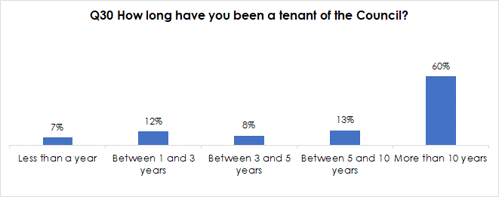
Age and Gender (Q31/32)
In terms of the age profile of respondents, 13% were aged 16-34, 32% between 35-54, 21% between 55-64 and 31% were aged 65 and over.
Q31 Which age band best describes you?
| Age | No. | % |
|---|---|---|
|
16-24 |
28 |
2% |
|
25-34 |
126 |
11% |
|
35-44 |
203 |
17% |
|
45-54 |
180 |
15% |
|
55-59 |
113 |
10% |
|
60-64 |
134 |
11% |
|
65-74 |
205 |
17% |
|
75+ |
161 |
14% |
|
Prefer not to say |
36 |
3% |
Q32 Which of the following describe how you think of yourself?
| Gender | No. | % |
|---|---|---|
|
Male |
423 |
36% |
|
Female |
762 |
64% |
|
In another way |
1 |
0% |
Household composition (Q33)
In terms of household composition, just under half of tenants (47%) lived in a single adult household, 20% in a household of two adults, 7% in a household of three of more adults, 14% were one-parent families and 7% were two-parent families.
Q33 How would you describe the composition of your household?
| Composition of your household | No. | % |
|---|---|---|
|
One adult under 60 |
57 |
22% |
|
One adult aged 60 or over |
149 |
26% |
|
Two adults both under 60 |
39 |
6% |
|
Two adults both over 60 |
46 |
9% |
|
Two adults, at least one 60 or over |
26 |
5% |
|
Three or more adults, 16 or over |
31 |
7% |
|
1 parent family with children at least 1 under 16 |
63 |
14% |
|
2 parent family with children at least 1 under 16 |
21 |
7% |
|
Other |
19 |
5% |
